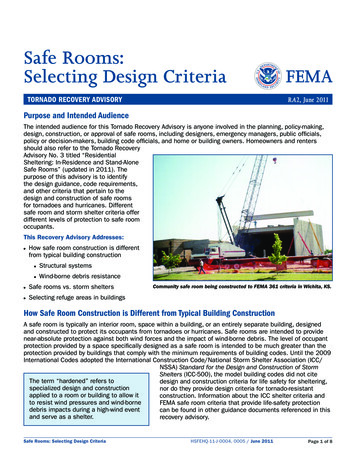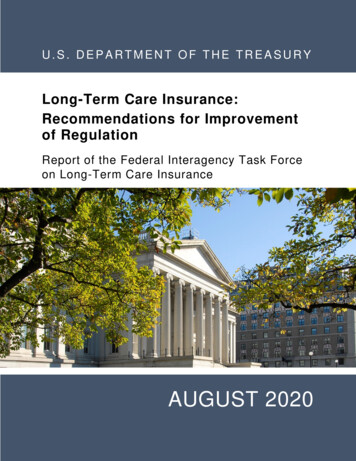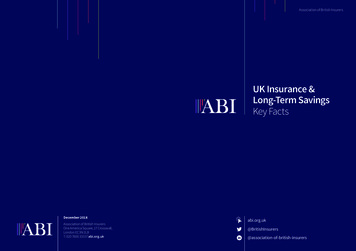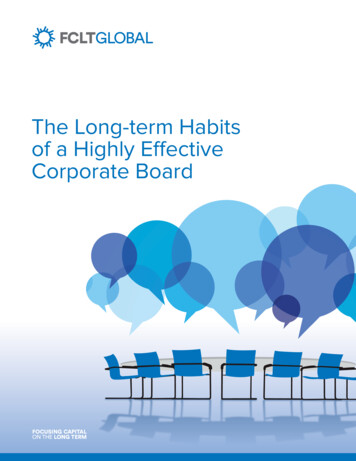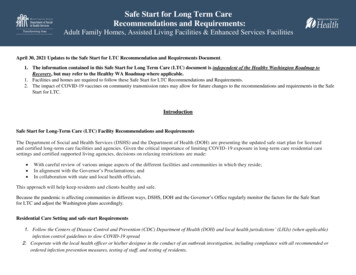
Transcription
Safe Start for Long Term CareRecommendations and Requirements:Adult Family Homes, Assisted Living Facilities & Enhanced Services FacilitiesApril 30, 2021 Updates to the Safe Start for LTC Recommendation and Requirements Document.1. The information contained in this Safe Start for Long Term Care (LTC) document is independent of the Healthy Washington Roadmap toRecovery, but may refer to the Healthy WA Roadmap where applicable.1. Facilities and homes are required to follow these Safe Start for LTC Recommendations and Requirements.2. The impact of COVID-19 vaccines on community transmission rates may allow for future changes to the recommendations and requirements in the SafeStart for LTC.IntroductionSafe Start for Long-Term Care (LTC) Facility Recommendations and RequirementsThe Department of Social and Health Services (DSHS) and the Department of Health (DOH) are presenting the updated safe start plan for licensedand certified long-term care facilities and agencies. Given the critical importance of limiting COVID-19 exposure in long-term care residential caresettings and certified supported living agencies, decisions on relaxing restrictions are made: With careful review of various unique aspects of the different facilities and communities in which they reside;In alignment with the Governor’s Proclamations; andIn collaboration with state and local health officials.This approach will help keep residents and clients healthy and safe.Because the pandemic is affecting communities in different ways, DSHS, DOH and the Governor’s Office regularly monitor the factors for the Safe Startfor LTC and adjust the Washington plans accordingly.Residential Care Setting and safe start Requirements1. Follow the Centers of Disease Control and Prevention (CDC) Department of Health (DOH) and local health jurisdictions’ (LHJs) (when applicable)infection control guidelines to slow COVID-19 spread2. Cooperate with the local health officer or his/her designee in the conduct of an outbreak investigation, including compliance with all recommended orordered infection prevention measures, testing of staff, and testing of residents.
3. Follow this DSHS and DOH Safe Start for LTC plan. This document is guidance for LTC and is not included in the Healthy Washington Roadmap toRecovery.4. Individual facility types have state statute or rules that requires a facility to impose actions to protect the residents by activating their infection controlplan.5. The LHJ or DOH have the authority to return a facility to more restrictive operations in response to any infectious disease and/or COVID-19 outbreak.o Examples that may require a facility to return to more restrictive operations include but are not necessarily limited to new outbreaks of COVID-19 intheir facility as determined by the LHJ or DOH. The LHJ and DOH under WAC 246-101-505 and WAC 246-101-605 have the authority to conductpublic health investigations and institute control measures and, pursuant to WAC 246-101-305, LTCs are obligated to cooperate with theseinvestigations. Please refer to the DOH definition of an outbreak found here: Interim COVID-19 Outbreak Definition for Healthcare SettingsAll facilities and agencies must be prepared for an outbreak and make assurances they have;1. Access to adequate testing: The facility must maintain access to COVID-19 testing for all residents and staff:a. Aiming for fast turnaround times, ideally less than 48 hours,b. Testing all clients with signs and symptoms of COVID-19 or has exposures,c. Working with local and state public health to coordinate repeat and outbreak testing, andd. Capacity to conduct ongoing, serial testing of clients and staff according to federal, state and local guidance;e. Testing includes point of care antigen testing and PCR lab testing.2. A response plan outlining cohorting and other infection control measures.3. A plan to actively screen all staff following the symptom screening strategies that can be found here: Infection Control: Severe acute respiratory syndromecoronavirus 2 (SARS-CoV-2) CDC and to screen all visitors using the DOH Supplemental Guidance for Long-term Care Facility Visitors.4. Dedicated space for cohorting and managing care for residents with COVID-19 or if unable to cohort residents, have a plan which may include transferringa person to another care setting.5. A plan in place to care for residents with COVID-19, including identification and isolation of residents. The home/facility or agency plan describingthe identification, care and isolation of residents or clients may be requested by DSHS, DOH or the LHJs to conduct an outbreak investigation. Technicalassistance for development of these plans can be received from LHJs.6. Protected and promoted resident and client rights while following standards of infection control practices including when a resident or a clientrequires quarantine or isolation due to individual disease status or an outbreak in a residential facility or client home.Core Principles of Safe Start and COVID-19These core principles are consistent with the Centers for Disease Control and Prevention (CDC) guidance for long-term-care, and should be adhered to at all times.Additionally, visitation should be person-centered, consider the residents’ physical, mental, and psychosocial well-being, and support their quality of life. The riskof transmission can be further reduced through the use of physical barriers (e.g., clear Plexiglas dividers, curtains). Also, providers should enable visits to bePhased Safe Start for LTC Recommendations and RequirementsAdult Family Homes, Assisted Living Facilities, and Enhanced Services FacilitiesPage 2 of 2004/30/2021
conducted with an adequate degree of privacy whenever possible. Visitors who are unable to adhere to the core principles of COVID-19 infection preventionshould not be permitted to visit or should be asked to leave. Providers may restrict or limit visitation due to facility/home COVID-19 status, a resident’s COVID19 status, visitor symptoms, visitor lack of adherence to proper infection control practices, or other relevant factors related to the COVID-19 public healthemergency. By following a person-centered approach and adhering to these core principles, visitation can occur safely based on the below guidance:Personal Protective Equipment (PPE)Providers will ensure visitors and those providing compassionate care wear proper source control (e.g., well-fitting cloth mask or facemask) at all times whenmoving about the facility. Visitors and those providing compassionate care will continue to wear source control during the indoor visit in the resident room ordesignated visiting area or during outdoor visits if either the resident or visitor is not fully vaccinated or the vaccination status of either party is unknown. Visitorswill wear all PPE recommended when indicated by standard or transmission based precautions . Facilities have the flexibility to safely manage visitation and maydeny a visitor access if they are unwilling to wear appropriate PPE. If the visitor is denied access, they will be given the Regional Long-Term Care Ombuds or theDevelopmental Disability Ombuds contact information (or both if appropriate to the situation), and Local Health Jurisdiction contact information. They must alsobe given information regarding the steps they can take to resume the visits, such as agreeing to comply with infection control practices and Washington Safe StartGuidelines. For additional guidance, see Contingency Strategies for PPE use during COVID-19 PandemicAll staff in the facility/home need to wear source control at all times, regardless of vaccination status, and all PPE recommended when indicated by standard ortransmission based precautions.Adult Family Homes providers and staff who live in the home may utilize the following strategies when in areas of the home residents do not gather: If the provider/staff have a separate living area that is not a part of the adult family home, they do not need to apply the AFH source control and PPEstrategies in their private living space. They may have visitors in this space and follow the CDC guidance for the general public in this area.If their personal bedroom is located in the licensed portion of the home, but residents do not enter, the provider or staff do not need to apply source controland PPE strategies in that room;If the provider/staff are alone in a room of the home and there is a limited chance residents or other staff will enter the space (i.e. residents are on anouting or in bed, no other staff are on duty, residents have limited mobility) the provider/staff does not need to apply the AFH source control and PPEstrategies at that time.If the provider has family or friends who visit a licensed area of the home (and do not live in the home), their visitors will need to wear source control andmaintain social distancing from any unvaccinated residents.Phased Safe Start for LTC Recommendations and RequirementsAdult Family Homes, Assisted Living Facilities, and Enhanced Services FacilitiesPage 3 of 2004/30/2021
Key Visitation PrinciplesVisitation can be conducted through different means, based on a facility/home’s structure, community virus activity, and residents’ needs, such as in residentrooms, dedicated visitation spaces, outdoors, and for circumstances beyond compassionate care situations. Regardless of how visits are conducted, there are certaincore principles and best practices that reduce the risk of COVID-19 transmission.Infection PreventionInfection prevention should entail the following basic concepts, at a minimum: Active screening of all who enter the facility/home for signs and symptoms of COVID-19 (e.g., temperature checks, questions or observations about signs orsymptoms), and denial of entry of those with signs or symptomsHand hygiene (use of alcohol-based hand rub is preferred)Face covering or mask (covering mouth and nose), and use of eye protection if appropriateSocial distancing at least six feet between personsInstructional signage throughout the facility and proper visitor education on COVID19 signs and symptoms, infection control precautions, other applicablefacility practices (e.g., use of face covering or mask, specified entries, exits and routes to designated areas, hand hygiene)Cleaning and disinfecting high frequency touched surfaces in the facility/home often, and designated visitation areas after each visitAppropriate staff use of Personal Protective Equipment (PPE)Effective cohorting of residents (e.g., separate areas dedicated COVID-19 care) if possibleOutdoor Visitation PrinciplesWhile taking a person-centered approach and adhering to the core principles of COVID-19 infection prevention, outdoor visitation is preferred and can also beconducted in a manner that reduces the risk of transmission. Outdoor visits pose a lower risk of transmission due to increased space and airflow. Therefore,outdoor visits are encouraged whenever practicable. Aside from weather considerations (e.g., inclement weather, excessively hot or cold temperatures, poor airquality), an individual resident’s health status (e.g., medical condition(s), COVID-19 status), or a facility’s outbreak status, outdoor visitation should be facilitatedroutinely. Facilities should create accessible and safe outdoor spaces for visitation, such as in courtyards, patios, or parking lots, including the use of tents, ifavailable. When conducting outdoor visitation, facilities should have a process to limit the number and size of visits occurring simultaneously to support safeinfection prevention actions (e.g., maintaining social distancing). We also recommend reasonable limits on the number of individuals visiting with any one residentat the same time. Outdoor Visitation Guidance for Long-term Care SettingsPhased Safe Start for LTC Recommendations and RequirementsAdult Family Homes, Assisted Living Facilities, and Enhanced Services FacilitiesPage 4 of 2004/30/2021
Indoor Visitation Principles Facilities should accommodate and support indoor visitation based on the following guidelines:o Visitors should be able to adhere to the core principles;o Facilities should consider how the number of visitors per resident at one time and the total number of visitors in the facility at one time (based onthe size of the building and physical space) may affect the ability to maintain the core principles of infection prevention. If necessary, facilitiesshould consider scheduling visits for a specified length of time to help ensure all residents are able to receive visitors.NOTE: Visits for residents who share a room should not be conducted in the resident’s room, if possible. For situations where there is a roommate and thehealth status of the resident prevents leaving the room, facilities/homes should attempt to enable in- room visitation while adhering to the core principles ofCOVID-19 infection prevention.Outbreaks VisitationResidents who are on transmission-based precautions for COVID-19 should only receive visits that are virtual, through windows, or in-person for compassionatecare situations, with adherence to transmission-based precautions. However, this restriction should be lifted once transmission based precautions are no longerrequired per CDC guidelines, and other visits may be conducted as described above. Facilities should consider visitation, group activities, and communal dininglimitations based on status of COVID-19 infections in the facility. Facilities have flexibility to determine what is best for resident and staff safety to managevisitation. The facility will take into consideration the scope of residents in isolation and quarantine status. For example, the facility may not allow communaldining, group activities, and visitors, compassionate care, and designated visitors if active COVID-19 throughout the entire physical plant. Or, they may restrictthese activities and visitation on particular wings/units with COVID-19 spread and allow on non-COVID units.Access to Ombuds and Resident Right AdvocatesWashington State laws and rules provide representatives of the Office of the State Long-Term Care Ombudsman and the Developmental Disabilities Ombuds withimmediate access to any resident. During this public health emergency, in-person access may be limited due to infection control concerns and/or transmission ofCOVID-19; however, in-person access may not be limited without reasonable cause. We note that representatives of the Ombuds should adhere to the coreprinciples of COVID-19 infection prevention. If in-person access is not advisable, such as the Ombuds or the resident having signs or symptoms of COVID-19,facilities must, at a minimum, facilitate alternative resident communication with the ombuds, such as by phone or through use of other technology. Providers willwork with Ombuds to coordinate and identify private meeting space that meets infection controls standards if visitation in the resident’s room is not possible.Federal and State Disability LawsProviders must comply with federal disability rights laws such as Section 504 of the Rehabilitation Act and the Americans with Disabilities Act (ADA). Forexample, if a resident requires assistance to ensure effective communication (e.g., a qualified interpreter or someone to facilitate communication) and theassistance is not available by onsite staff or effective communication cannot be provided without such entry (e.g., video remote interpreting), the facility/homePhased Safe Start for LTC Recommendations and RequirementsAdult Family Homes, Assisted Living Facilities, and Enhanced Services FacilitiesPage 5 of 2004/30/2021
must allow the individual entry into the facility/home to interpret or facilitate, with some exceptions. This would not preclude facilities/homes from imposinglegitimate safety measures that are necessary for safe operations, such as requiring such individuals to adhere to the core principles of COVID-19 infectionprevention.Medically Necessary Providers, Service and Health Care Workers PrinciplesHealth care workers who are not employees of the facility but provide direct care to the facility’s residents, such as hospice workers, Emergency Medical Services(EMS) personnel, dialysis technicians, laboratory technicians, radiology technicians, social workers, clergy etc., must be permitted to come into the facility as longas they are not subject to a work exclusion due to an exposure to COVID-19 or show signs or symptoms of COVID-19 after an active screening process. We notethat EMS personnel do not need to be screened so they can attend to an emergency without delay. We remind facilities that all staff, including individualsproviding services under arrangement as well as volunteers, should adhere to the core principles of COVID-19 infection prevention and must comply withCOVID-19 testing requirements.Communal Activities and Dining PrinciplesWhile adhering to the core principles of COVID-19 infection prevention, communal activities and dining may occur. The facility/home must utilize the followingcriteria to determine the best approach to communal activities and dining:Who must not participate in communal activities? Vaccinated and unvaccinated residents with SARS-CoV-2 infection, or in isolation because of suspected COVID-19, until they havemet criteria to discontinue Transmission-Based Precautions.Vaccinated and unvaccinated residents in quarantine until they have met criteria for release from quarantine.What infection prevention and control practices are recommended when planning for and allowing communal activities?Determining the vaccination status of residents/healthcare professional (HCP) at the time of the activity might be challenging and might be subject to localregulations. When determining vaccination status, the privacy of the resident/HCP should be maintained (e.g., not asked in front of other residents/HCP). Forexample, when planning for group activities or communal dining, facilities might consider having residents sign up in advance so their vaccination status can beconfirmed and seating assigned. If vaccination status cannot be determined, the safest practice is for all participants to follow all recommended infectionprevention and control practices including maintaining physical distancing and wearing source control.Phased Safe Start for LTC Recommendations and RequirementsAdult Family Homes, Assisted Living Facilities, and Enhanced Services FacilitiesPage 6 of 2004/30/2021
Group activities:o If all residents participating in the activity are fully vaccinated, then they may choose to have close contact and to not wear source control duringthe activity.o If unvaccinated residents are present, then all participants in the group activity should wear source control and unvaccinated residents shouldphysically distance from others.Communal dining:o Fully vaccinated residents can participate in communal dining without use of source control or physical distancing.o If unvaccinated residents are dining in a communal area (e.g., dining room) all residents should use source control when not eating andunvaccinated residents should continue to remain at least 6 feet from others.“Cohort” activities/dining based on vaccination status:o The facility/home may host separate activities/dining based on vaccination statuso The facility/home must ensure that they continue to comply with Resident Rights requirementsOffsite VisitsProviders must use the Risk Assessment Template to assess each resident for any COVID-19 exposure after returning from offsite visits to determine if theresident is low or high risk. Automatic quarantine should not be the standard practice upon returning from a trip into the community. Decisions about precautionstaken with a resident as a result of the assessment must be documented in the resident’s care plan.Outside Safety Related to StructuresProviders must follow state fire marshal requirements for safety related to tent use or other temporary shelter structures: proper installation and suitable anchoring,flame resistant product use, protection of residents, tents, and surrounding grounds must be free of combustible materials, not obstruct fire hydrants, smoke freeand equipped with smoke free signs, comfortable temperatures, fire marshal approved only heater use, no open fires/flames within or around tents, fire marshalapproved only lighting sources, clear unobstructed path for egress, easily opened doors and zippers, hard packed walking surfaces with no tripping hazards, andillumination of operating in dark hours. Providers must ensure resident wear proper clothing for outdoor climate, and promote outside safety and comfortabletemperatures via a structured shelter, parking lot, patio, or courtyard venue. Outdoor Visitation Guidance for Long-term Care Settings.Holiday GuidanceProviders should follow CDC guidelines for holidays. Where State or LHJ guidance provides stricter measures, providers must follow the stricter guidance. Thisguidance does not replace state proclamation requirements, DOH, and CDC link: CDC recommendations for Holiday Celebrations and Small Gatherings.Providers must follow all guidelines for visitation within this document with strict adherence to infection control principles to prevent the spread and transmissionof COVID-19.Phased Safe Start for LTC Recommendations and RequirementsAdult Family Homes, Assisted Living Facilities, and Enhanced Services FacilitiesPage 7 of 2004/30/2021
Negotiated Care Plans/Negotiated Service AgreementsBecause person-centered care is key, providers will document in the resident care plan medically necessary care, compassionate care, and designated person caredelivery.Continuing Care Retirement Communities (CCRC) and Independent Living CampusState licensed homes that reside on the same campus as CCRCs and independent living settings, must follow these recommendations for Safe Start Long TermCare Recommendations. Refer to the Department of Health guidance for shared water recreation VID-19.pdf.Section I – Safe Start of FacilitiesConsiderationMitigation StepsVisitationSee Section IIEssential/Non-Essential Personnel All essential healthcare personnel, includinghealthcare personnel addressed in DearProvider letter 20-062, are allowed into thefacility/home at all timesAll non-healthcare personnel are allowed inthe building if the facility/home is not inoutbreak status. If the facility/home hascohorted COVID positive residents to oneunit and the rest of the building is open, thenon-healthcare personnel may visit areas notin outbreak status. Because non-healthcarepersonnel have the potential for contact withunvaccinated staff or residents, they mustwear source control and physically distanceat all times while in the building regardlessof their own vaccination status.Phased Safe Start for LTC Recommendations and RequirementsAdult Family Homes, Assisted Living Facilities, and Enhanced Services FacilitiesPage 8 of 2004/30/2021
ConsiderationMitigation Steps All personnel participate in active screeningupon entry and additional precautions aretaken, including hand hygiene, donning ofappropriate PPE, as determined by the task;and at a minimum wearing a face mask forthe duration of their visit.The Beautician/Barber/Nail Technician musthave a designated space.Essential healthcare personnel such as NurseDelegators will follow DOH guidance fornurse delegation. Medically and Non-Medically Necessary Trips Telemedicine is encouraged whenavailable. For medically and non-medicallynecessary trips away from of the facility:o The resident must be encouraged towear a cloth face covering when thetrip will involve entering spaceswhere source control is still requiredunless wearing source control ismedically contraindicated for theresident; ando The facility must share the resident’sCOVID-19 status with thetransportation service and entity withwhom the resident has theappointment.Transportation staff, at a minimum, mustwear source control. Additional PPE may berequired.Transportation equipment shall be sanitizedbetween transports.Residents can make trips outside of thebuilding and into the community, includingPhased Safe Start for LTC Recommendations and RequirementsAdult Family Homes, Assisted Living Facilities, and Enhanced Services FacilitiesPage 9 of 2004/30/2021
ConsiderationMitigation Stepsnon-medically-related trips, to locations thatare open to the public. However, residentsare encouraged to limit or avoid trips whereappropriate precautions are not beingfollowed.o Adult Family homes please see DearAdministrator letter AFH 020-027 fordetails regarding residents leaving thefacility for non-medically necessarytrips.o Assisted Living Facilities please seeDear Administrator Letter ALF 020-028for details regarding residents leaving thefacility for non-medically necessarytrips.o Enhanced Services Facilities Please seeDear Administrator Letter ESF 020-021for details regarding residents leaving thefacility for non-medically necessarytrips.o Provide a letter to Families and residentsoutlining potential risks involved incommunity activities whenresidents/clients are preparing for anouting. Upon the resident return to thefacility/home complete a riskassessment. Both the letter and theassessment can be found here: RiskAssessment Template to Assess COVID19 Exposure Risk and letter toResident/Clients and Families.o If the resident/client or family hasalready reviewed the risk letter forprevious outings, it is not necessary toprovide a new letter with each trip intoPhased Safe Start for LTC Recommendations and RequirementsAdult Family Homes, Assisted Living Facilities, and Enhanced Services FacilitiesPage 10 of 2004/30/2021
ConsiderationMitigation Stepsthe community unless the informationhas changed.Communal Dining Screening Fully vaccinated residents can participate incommunal dining without use of sourcecontrol or physical distancing.If unvaccinated residents are dining in acommunal area (e.g., dining room) allresidents should use source control when noteating and unvaccinated residents shouldcontinue to remain at least 6 feet from others.If unvaccinated staff assist with dining, allresidents and staff in the dining room willwear source control.Facilities/homes may host separate diningbased on vaccination status. If choosing to doso, the facility/ home must ensure that theycontinue to comply with Resident Rightsrequirements.If staff assistance is required, staff must useappropriate hand hygiene between residentsand before and after meals.Staff must continue to wear source controlregardless of vaccination status.Disinfect all dining tables and eating surfacesbefore and after meals.Active screening must continue as outlinedbelow regardless of vaccination statusActively screen residents daily.Actively screen 100% of all persons(residents, staff, visitors, etc.) entering/reentering the facility/home including:temperature checks, questionnaire aboutsymptoms and potential exposure,Phased Safe Start for LTC Recommendations and RequirementsAdult Family Homes, Assisted Living Facilities, and Enhanced Services FacilitiesPage 11 of 2004/30/2021
ConsiderationMitigation Steps Universal Source Control & Personal ProtectiveEquipment (PPE) Cohorting & Dedicated Staff observation of any signs or symptoms, andensure all people entering the facility orhome have cloth face covering or face mask.Maintain a screening log for 30 days.Do not screen EMTs or law enforcementresponding to an emergent call.All staff, regardless of their position, mustuse source control at all times regardless ofvaccination status.If the county case count is greater than 25per 100,000, staff must wear eye protectionwhen providing care or social distancingcannot be maintained. County Case CountsAll staff and essential personnel, must wearappropriate source control or PPE when theyare interacting with residents, to the extentPPE is available, and in accordance withCDC PPE optimization strategies.All visitors must wear source control (e.g.,well-fitting cloth mask or face mask) whenmoving about the facility/home.Visitors must wear source control whenvisiting with a resident if the resident orvisitor (or both) is unvaccinated or thevaccination status is unknown.Additional universal source controlrecommendations can be found throughoutthis document (e.g., visitors, essentialhealthcare personnel).Follow LHJ guidance for any isolation andcohorting of residents.Depending on the number of rooms and sizeof the home, the provider may have toPhased Safe Start for LTC Recommendations and RequirementsAdult Family Homes, Assisted Living Facilities, and Enhanced Services FacilitiesPage 12 of 2004/30/2021
ConsiderationMitigation Steps Group Activitiestransfer residents who are symptomatic ortesting positive for COVID-19.Plans must be in place to:o Monitor residents who test positiveand have roommates in the home;o Manage new admissions andreadmissions with an unknownCOVID-19 status;o Manage residents who routinelyattend outside medically-necessaryappointments (e.g., dialysis);o Monitor staff who work withmultiple clients and agencies. When determining vaccination status, theprivacy of the resident/staff should bemaintained (e.g., not asked in front ofother residents/staff). For example,when planning for group activities orcommunal dining, facilities mightconsider having residents sign up inadvance so their vaccination status canbe confirmed and seating assigned.If vaccination status of residents or staffcannot be determined, the safest practiceis for all participants to follow allrecommended infection prevention andcontrol practices including maintainingphysical distancing and wearing sourcecontrol.Group activities:oIf all residents participating in theactivity are fully vaccinated, thenthey
Adult Family Homes, Assisted Living Facilities, and Enhanced Services Facilities Page 4 of 20 04/30/2021 Key Visitation Principles Visitation can be conducted through different means, based on a facility/home's structure, community virus activity, and residents' needs, such as in resident








